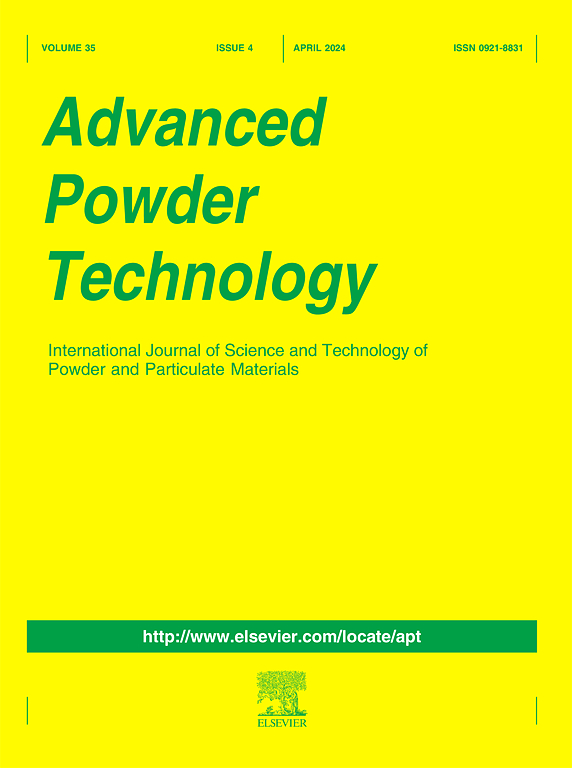Microwave sintering of lithium hydride by powder metallurgy: Grain growth kinetics and densification mechanism
IF 4.2
2区 工程技术
Q2 ENGINEERING, CHEMICAL
引用次数: 0
Abstract
In this study, the effect of microwave sintering on the densification and microstructure of lithium hydride (LiH) cylindrical bulk samples was investigated. The lithium hydride powders were cold pressed into cylindrical shapes and then sintered at temperatures ranging from 450 °C to 550 °C. Microwave sintering demonstrates substantial advantages in achieving accelerated densification and superior microstructural uniformity. Analyses of phase composition, bulk density and micromorphology show that microwave-sintered LiH has a denser grain structure and fewer surface pores. The change in bulk density of bulk LiH sample during microwave sintering shows that the activation temperature of densification is about 475 °C. The average grain size of the bulk LiH sample grows from 46 μm to 53.2 μm. In addition, kinetic modelling showed that microwave sintering was carried out by grain boundary diffusion with lower activation energy, resulting in improved sintering efficiency and shorter processing time. The activation energy for grain growth is 73 kJ/mol. These findings highlight the potential of microwave sintering as an energy-efficient and effective method to produce high-quality bulk LiH materials, paving the way for advanced applications in hydrogen storage and energy systems.

粉末冶金微波烧结氢化锂:晶粒生长动力学和致密化机理
研究了微波烧结对氢化锂(LiH)圆柱形体试样致密化和微观结构的影响。将氢化锂粉末冷压成圆柱形,然后在450 ~ 550℃的温度下烧结。微波烧结在实现加速致密化和优异的显微组织均匀性方面显示出实质性的优势。相组成、容重和微观形貌分析表明,微波烧结的LiH具有更致密的晶粒结构和更少的表面孔隙。微波烧结过程中LiH样品的容重变化表明,致密化的激活温度约为475℃。LiH样品的平均晶粒尺寸从46 μm增大到53.2 μm。动力学模拟表明,微波烧结以晶界扩散方式进行,具有较低的活化能,提高了烧结效率,缩短了加工时间。晶粒生长的活化能为73 kJ/mol。这些发现突出了微波烧结作为一种生产高质量大块锂材料的节能有效方法的潜力,为氢储存和能源系统的先进应用铺平了道路。
本文章由计算机程序翻译,如有差异,请以英文原文为准。
求助全文
约1分钟内获得全文
求助全文
来源期刊

Advanced Powder Technology
工程技术-工程:化工
CiteScore
9.50
自引率
7.70%
发文量
424
审稿时长
55 days
期刊介绍:
The aim of Advanced Powder Technology is to meet the demand for an international journal that integrates all aspects of science and technology research on powder and particulate materials. The journal fulfills this purpose by publishing original research papers, rapid communications, reviews, and translated articles by prominent researchers worldwide.
The editorial work of Advanced Powder Technology, which was founded as the International Journal of the Society of Powder Technology, Japan, is now shared by distinguished board members, who operate in a unique framework designed to respond to the increasing global demand for articles on not only powder and particles, but also on various materials produced from them.
Advanced Powder Technology covers various areas, but a discussion of powder and particles is required in articles. Topics include: Production of powder and particulate materials in gases and liquids(nanoparticles, fine ceramics, pharmaceuticals, novel functional materials, etc.); Aerosol and colloidal processing; Powder and particle characterization; Dynamics and phenomena; Calculation and simulation (CFD, DEM, Monte Carlo method, population balance, etc.); Measurement and control of powder processes; Particle modification; Comminution; Powder handling and operations (storage, transport, granulation, separation, fluidization, etc.)
 求助内容:
求助内容: 应助结果提醒方式:
应助结果提醒方式:


